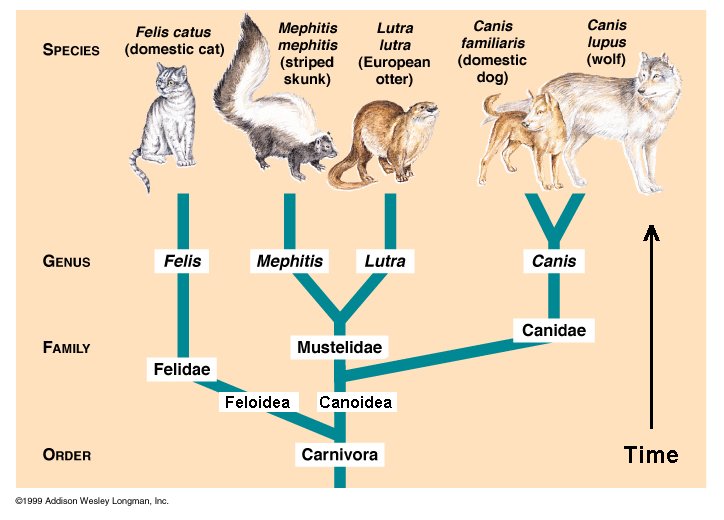On my blog, I have uploaded a couple of posts about classification of animals, discussing the kingdoms and phyla. Today I want to talk more generally about the binomial system, focusing on how it developed and its advantages.
Development of the binomial system

As scientists were discussing various organisms, it was important that all biologists use the same system of names to prevent confusion. The idea was first proposed by the International Botanical Congresses (IBC) in 1892 to develop consistent binomials for all species of plants. This idea was accepted and all plants were given a specific, universal name. The year 1753, when Linnaeus published Species Plantarum, a book with binomials for all species of the plant kingdom.
Meanwhile, the need for rules for naming and classifying animal species was recognized in the International Zoological Congress. It was agreed that the year 1758 would be the starting date for naming animal species, since this was when Linnaeus published his book Systema Natura, in which he provided binomials of all species that were then known.
The naming system of plants and animals were combined to form the binomial system that gives the international name of a species that consists of two words. The first name would be the genus (a group of species that share certain characteristics) name, and the second name is the species or specific name. There are several rules to follow:
- A binomial is shown in italics in typed or printed text.
- A binomial can be abbreviated to the initial letter of the genus name with the full species name after it has been used once in a piece of text.
- The genus name starts with a capital letter and the species name with a small letter.
- The earliest published name is correct from 1753 onwards for plants or 1758 for animals.
In taxonomy, there is a hierarchy, as each taxon includes taxa from the level below. Every species is classified into a genus, which are grouped into families. Families are then grouped into orders, orders into classes, classes up to a kingdom or domain. So the genus is at the bottom of the hierarchy while a kingdom or a domain is at the top. As we go up the hierarchy, the taxa include larger numbers of species that share fewer features.
Natural classification
Natural classification is closely linked to the central idea of evolution: all species come from a common ancestor. Due to the common ancestry, we can expect the members of a natural group to have shared features. When birds, bats, and insects are grouped together since they can all fly, unnatural or artificial classification occurred since flight evolved separately in these groups. Another example of artificial classification would be to classify plants and fungi together as they have cell walls and are immobile. Yet, their cell walls evolved separately, so they should not be put in the same group.

Natural classification can be problematic since it’s not clear which groups of species share an ancestor. A significant factor is convergent evolution, which makes it seem like distantly related organisms are similar. Also, adaptive radiation makes closely related organisms seem different. In order to counter these problems, molecular biology has been used to analyze whether species are distantly or closely related.
When new evidence shows that a previous taxon contains species that did not share a common ancestor with the rest of the group, taxonomists reclassify the organisms. A famous example is the classification of humans. Under standard conventions, humans are considered to be in the order Primates and the family Hominidae. There were controversy over whether the great apes should be included in this family. The classification got even more complex when research showed that chimpanzees and gorillas are closer to humans than orangutans. Meanwhile, there is evidence to suggest that gorillas are closer than gorillas to humans , but if humans and chimpanzees are categorized into different genera, gorillas should also be in a different genus.
Although there are complexities and problems with natural classification, there are huge advantages to using this system. One advantage is that identification of species is easier. When it is not obvious to find the species of an organism, the specimen can be considered in the hierarchy of taxonomy. It will first be classified into its kingdom, then the phylum, and eventually down to the species level. This process does not work for artificial classification, which gives natural classification a unique benefit.
The second advantage is that it is possible to predict the characteristics of a species within a group considering that members of a group evolved from a common ancestor. For instance, if a substance that can assist in developing medicine is found in one plant in a species, it is likely that this substance is present in other plants in the same genus. These predictions cannot be made by artificial classification.
Works Cited
Allott, Andrew. Biology: Course Companion. Oxford University Press, 2014.
“Brent Cornell.” BioNinja, ib.bioninja.com.au/standard-level/topic-5-evolution-and-biodi/53-classification-of-biodiv/binomial-system.html.
Carr, Steven M. Natural Classification & Phylogeny, http://www.mun.ca/biology/scarr/Natural_Classification.html.
Leave a comment